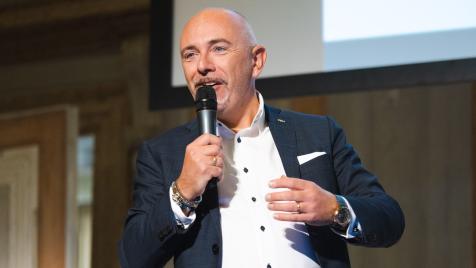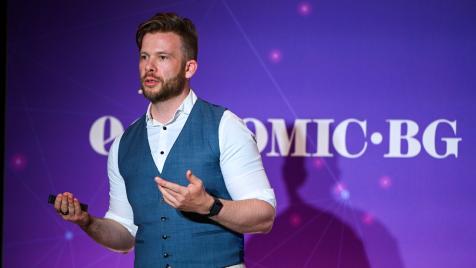Video Marketing: A Powerful Tool Many Companies Use the Wrong Way
Video is widely recognized as the most compelling and effective medium for driving engagement and influence in digital marketing

© ECONOMIC.BG / ExpandX
What are the most common mistakes brands make in video marketing? How can they avoid them – and what truly drives successful results? To answer these questions, we speak with Polina Decheva, Partner at ExpandX Marketing & Web and Head of the agency’s Video Marketing team.
Drawing on hands-on experience from campaigns executed for the agency’s clients across more than 15 countries in Europe, North America, and the Middle East, Polina shares practical insights and lessons learned from the field—revealing what separates effective video marketing from the rest.
Video content dominates the digital space. What are the biggest mistakes you see brands make?
Video is widely recognized as the most compelling and effective medium for driving engagement and influence in digital marketing. No other format can establish emotional connection and build online trust with the same effectiveness. And those two factors—connection and trust—dramatically reduce the friction of getting in touch with a business and, in e-commerce, making the purchase itself.
Yet, while the advantages of video are indisputable, many organizations struggle to leverage it effectively. By underestimating the strategic and creative work behind video production, they risk damaging rather than enhancing their brand presence online.
From what we see at ExpandX, the biggest mistakes fall into two categories: insufficient strategic planning and weak audience retention.
There are no sustainable results without a thoughtful, consistent strategy—this applies fully to video marketing, whether we’re talking about organic posts or paid campaigns. Before recording a single minute, you need answers to a few core questions: where does this video sit in the marketing funnel, what is its purpose, and how exactly will it support our brand perception, trust, or sales? Those decisions shape everything that follows—your script, message, and visual plan.
The same thinking applies to “free value” content. Yes, by definition it should bring value to your audience, but it also needs to deliver a direct benefit to your business—by building trust, creating an authentic connection, or establishing authority and leadership in your niche. Marketing is deeply rooted in psychology, and even the smallest details can have a powerful influence on the viewer.
And we should never forget that video works best as a system. You don’t just need a strategy for a single effective video—you need a cohesive system of paid and organic videos that fit together like puzzle pieces to reveal the bigger picture over time.
Strategic planning sounds like the obvious thing to do, yet strategy is often the most overlooked step—especially for smaller businesses. It’s common for owners to publish videos themselves, which is where mistakes are most visible: blending corporate messages with personal life content, or blindly chasing the latest social trend—tactics that rarely help the brand.
Another strategic misstep is publishing too much free content. We have all heard about “the power of free” and the importance of delivering value with our content. That’s true—but without the right balance you risk devaluing your product (especially if you sell digital products such as courses, online workouts, diet guides, etc.).
Apart from planning flaws, another recurring challenge lies in capturing attention. Many brands produce monotonous videos with unclear messaging, sluggish pacing, missing subtitles, and a complete lack of visual energy or variety.
We need to drop the idea that organic posts are “free” for the audience. People pay with their time—and we must earn that time with genuinely high-quality, engaging content.
In a world where the next interesting thing is one thumb-scroll away, holding attention is the ultimate challenge. It’s a myth that the first three seconds alone decide a video’s fate. The opening is just the initial hook, but the entire video - its shooting, its editing from start to finish—must be crafted to keep viewers watching.
How has audience attention changed in recent years—and does that mean everything must be short-form?
Attention is getting shorter and more selective. Viewer behavior is driven by rapid, split-second decisions. When it comes to video, viewers usually decide within just a second or two whether it’s worth watching—and every pause, drop in energy, or unclear moment gives them a reason to scroll away.
Algorithms reward videos with higher average watch time, as it’s one of the clearest indicators of strong viewer retention. The more concise, dynamic, and content-rich a video is, the greater its chances of gaining more visibility—and even going viral. Together, shrinking attention spans and algorithmic priorities have cemented short-form video as the dominant format on Facebook, Instagram, and TikTok.
At the core of video content creation is the fight for attention. Winning that first glance is only half the battle—the real skill lies in keeping viewers hooked until the very last second. To do that, a video needs visual rhythm, focused storytelling, energetic pacing, and a touch of ongoing intrigue.
But not everything should be short-form. Different video lengths serve different business goals, and they work best together — it’s not an “either/or” question.
Short-form videos are highly effective in the early stages of the customer journey, helping to establish brand awareness and attract new audiences. Similar to a movie trailer, they capture attention through energy and intrigue, providing just enough information to stimulate interest.
Longer videos shine once initial contact has been established and the goal has shifted to strengthening the relationship and building trust. A detailed YouTube video or a podcast appearance can effectively showcase the value of your product or service and play a decisive role in the customer’s final choice.
Another significant benefit of long-form content lies in YouTube itself—the world’s second-largest search platform after Google. With proper optimization, your videos remain discoverable for years, helping new audiences find you through search while strengthening your overall SEO presence.
Which metrics truly matter when measuring a video campaign’s success? Are view counts enough?
There isn’t a one-size-fits-all metric for measuring video performance, as each stage of the marketing funnel serves a different purpose and drives distinct audience behaviors.
At the Awareness stage—the top of the funnel—view counts can be a useful indicator of whether your content successfully captured attention.
Another key indicator at this stage is average watch time (Average Play Time / Average Minutes Viewed). On Meta, for instance, a “view” registers when playback starts—so if you look only at views, you won’t know whether people kept watching. Average watch time indicates not just whether the content was viewed, but whether it sustained engagement sufficiently for the marketing message to be absorbed.
At every stage of the marketing funnel, our focus remains on achieving the highest possible watch time. At ExpandX Marketing & Web we’ve developed a specific methodology for filming and editing video ads that capture attention in the opening seconds—and then keep re-earning it throughout the video.
Watch time also matters for organic posts. Algorithms will “test” your video with a small audience; strong retention earns a larger batch, and then a larger one again. High average watch time is one of the core patterns behind viral videos.
Back to view counts: as you move down the funnel, they matter less. Once the goal is action, not just visibility, other metrics take priority.
Based on our team’s experience, only a small number of clients allocate budgets specifically for brand awareness initiatives. The majority of paid video campaigns are performance-driven, targeting lead generation, sales, or other tangible outcomes—making view count a secondary metric.
In the Consideration stage, CTR (click-through rate) becomes critical. Here the goal shifts from brand awareness to active interest. CTR reveals whether the creative and messaging are persuasive enough to prompt action. A high CTR signals that our targeting, copy, and visuals effectively resonate with the audience.
For lead-generation campaigns, we focus on metrics such as CPL (cost per lead), total leads generated, and lead form completion rate. These indicators are far more meaningful than view counts, as the goal is to drive measurable actions.
For example, if a video designed to generate leads receives one million views but results in a high CPL and few actual leads, those views can’t be considered a success—they simply don’t translate into real results.
Moving one step further down the funnel to the Conversion stage, view count again takes a back seat. What matters here are tangible, measurable actions—purchases, bookings, and sign-ups.
Performance is evaluated through the same metrics we’d use in any conversion-focused campaign, with conversion rate leading the way as the clearest measure of effectiveness. A strong conversion rate shows that the ad didn’t just capture attention—it motivated action.
We also track ROAS (return on ad spend), CAC (customer acquisition cost), and AOV (average order value), all of which are key to understanding the true financial impact of your marketing efforts.
Storytelling has always mattered. How do we adapt it to a world of 15-second videos?
A story can be told through words—or through visuals. A series of powerful scenes and compelling images can evoke ideas, emotions, and memories, crafting a narrative with a speed that language alone can’t always achieve. When approached creatively, even a 15-second limit can produce something truly memorable and emotionally resonant.
So yes, you can absolutely tell a story in 15 seconds—but you don’t have to. Storytelling is woven into human nature and will never disappear just because social platforms push an unnatural consumption tempo.
Short videos are—and will continue to be—just one expression of storytelling. They don’t replace or lessen the impact of classic storytelling, which works precisely because it gives the story time and space to unfold, to breathe, and be absorbed and felt on a deeper level.
The latest marketing trends will be among the key highlights of MastersCONF 2025 — one of the most anticipated business events of the year.
Taking place on November 20, the conference will unite leading experts from top Bulgarian and international companies to share proven strategies for success in technology, marketing, sales, business development, management, and human resources.
ExpandX Marketing & Web is a co-organizer of the event, which is set to bring together hundreds of professionals, business leaders, and entrepreneurs for a day of inspiration, networking, and knowledge exchange focused on both personal and professional growth.
As part of the forum, ExpandX will provide every participant with a free audit of their company website, along with more exclusive gifts and surprises prepared for the guests.
MastersCONF 2025 promises to deliver not just insights but real momentum—a chance to experience the mindset, energy, and innovation that power today’s most successful companies.

 *
* 


